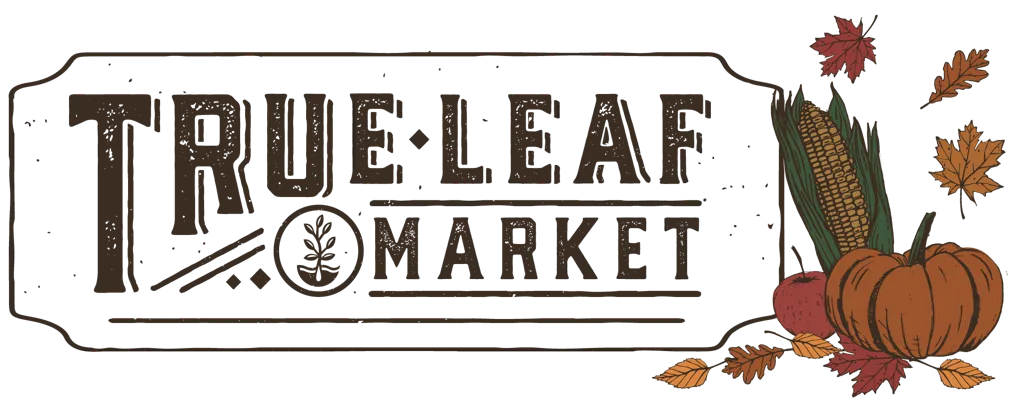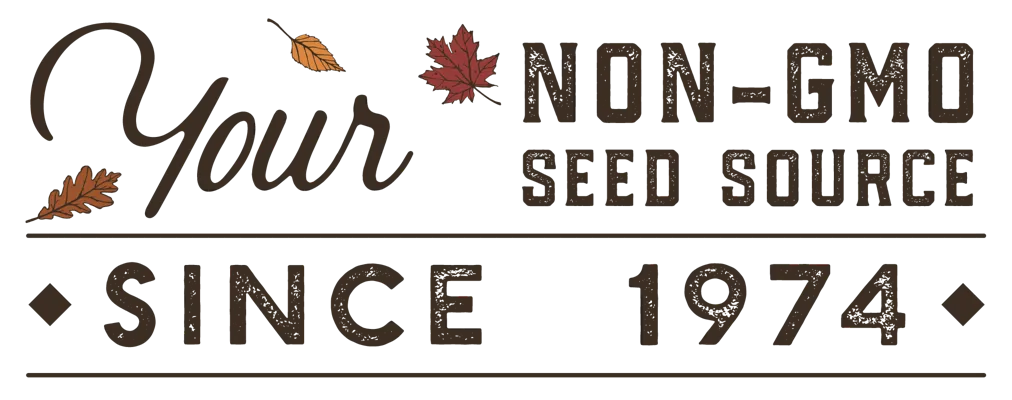Download Free Vegetable Growing Guide PDF
Growing Pinot Noir Hybrid Peppers in the Vegetable Garden
To get a head start on your Hybrid Pinot Noir peppers, sow the seeds indoors about six to eight weeks before the last expected frost date in your area. Plant the seeds about a quarter inch deep in a well-draining seed starting mix. You can use seed starting cells or flats but remember to thin the seedlings once they sprout or space them 2-3 inches apart. Once the seedlings emerge from the soil, they need 8-14 hours of direct sunlight or grow light exposure daily. If the seedlings outgrow their containers, transplant them into larger 4 or 6-inch pots. Keep them at the same soil level and trim off any leaves that might touch the soil.
While your seedlings are germinating and growing indoors, maintain consistently moist soil, letting it dry out just a little between waterings once the roots are well-established. When daytime temperatures reliably stay above 60 F, and the last frost date is near, start hardening off your seedlings. This involves placing them outside for gradually longer periods over 1-2 weeks, bringing them back inside if temperatures drop too much. This gradual exposure helps them adjust to outdoor conditions before transplanting them into the garden.
Once there's no longer a threat of frost and nighttime temperatures remain above 50 F, your pepper seedlings are ready for the garden. Prepare the garden bed by ensuring the soil is well-draining and fertile. Adding well-rotted compost can greatly enhance soil quality. Transplant the seedlings 12-18 inches apart, keeping them at the same depth as in their pots, and remove any branches or leaves that might contact the soil. After planting, water them thoroughly to eliminate air pockets. Continue to water regularly throughout the growing season, and consider applying a second round of fertilizer or compost to boost your pepper yields.
Harvesting Pinot Noir Hybrid Peppers
These large, stuffing peppers can be harvested when green or purple. The green peppers taste slightly earthy and bitter, whereas the purple peppers are sweet and earthy. Harvest the peppers promptly when they ripen to encourage more yields. Use a knife to take the peppers off the plant. Pulling or twisting can damage the plant and reduce yields.
About Pinot Noir Hybrid Pepper Garden Seeds
Pinot Noir Hybrid pepper plants are cool or warm regions.
The five-inch fruits with three or four lobes are pale purple, almost lilac-colored hybrid is a must for a color mixture of bells, some of which can appear almost black.
Also tolerant of humidity, Pinot Noir Hybrid peppers are incredibly unique in their coloring. No other pepper variety has quite the same look and taste.
Pinot Noir Hybrid plants stay compact and are good for smaller spaces. They rarely need additional support.
Stories From Our Gardeners
"You never know what you’re going to get with the Pinot Noir peppers. They can come on as black, purple, light purple, or even a dirty cream color at times. The excitement at harvest time is addicting!"
 |
- Lara Wadsworth, True Leaf Market Writer
|
Other Resources
Pinot Noir Hybrid Pepper Seeds Per Package:
- 300mg - Wholesale - Approximately 40 Seeds
- .25 oz - Wholesale - Approximately 1,000 Seeds
- 1 oz - Bulk Seeds - Approximately 4,000 Seeds
- 4 oz - Bulk Seeds - Approximately 16,000 Seeds
- 1 lb - Bulk Seeds - Approximately 64,000 Seeds
Non-GMO Pinot Noir Hybrid Pepper seeds are available for Fast Free Shipping on qualifying orders.
ATTRIBUTES
Basic Info
| Latin Name: |
Capsicum annuum
|
| Pepper Type: |
Sweet - These peppers (think Bell Peppers) are almost all at 0 on the Scoville Scale, meaning that they have no heat at all. A handful of sweet peppers do register very low on the Scoville scale but are still classed as sweet peppers. For example, Pepperoncinis are sweet peppers but usually rank around 100 to 500 on the Scoville Scale. |
| Pinot Noir Pepper Color: |
Purple |
| Pinot Noir Pepper Flavor: |
Fresh and sweet flavor |
Growing Info
| Hardiness Zone: |
4, 5, 6, 7, 8, 9, 10, 11, 12, 13 Technically a tender perennial, but commonly grown as an annual. Perennial in zones 10 and 11. |
| Days to Maturity: |
60-69 (from transplant) |
| Days to Germination: |
7-10 |
| Seeding Depth: |
0.25 inch |
| Plant Spacing: |
12-18 inches |
| Row Spacing: |
24-36 inches |
| Plant Height: |
12-18 inches |
| Growth Habit: |
Upright |
| Soil Preference: |
Well-draining, loose (sandy loam), slightly acidic (6.5 pH), and moisture retaining. Too much nitrogen in the soil may lead to more foliage production and less fruiting, similar to tomatoes. Peppers also need sufficient amounts of phosphorus and calcium. We recommend using a balanced fertilizer for the best results. |
| Temperature Preference: |
Warmer (70-85 F). During high heat, foliar and flower development slow or pause until temperatures return to the preferred range. |
| Light Preference: |
Full Sun |
Other
| Direct Sow: |
No |
| Start Indoors: |
Yes. Start Indoors 6-8 weeks before your last spring frost date. Harden off and transplant when seedlings are 6-8 inches tall. Bury the stem slightly deeper than the root ball. Avoid planting hot and sweet peppers right next to each other, as they can cross-pollinate, potentially affecting the flavors of your harvested peppers. |
| Pepper Pollination: |
Peppers have perfect flowers (male and female parts) and will self-pollinate. However, wind and pollinator activity may increase success rates of fertilization and fruit production. |
| Plant Width: |
12-18 inches |
| Deer Resistant: |
No |
| Scoville Heat Units: |
0 |
| Heat Level: |
Sweet - Peppers with no heat. 0-99 on the Scoville Scale. Example: Bell Peppers |
| Germination Temperature: |
80-90 F |
| Pests and Diseases: |
Peppers are commonly susceptible to cutworms, aphids, flea beetles, bacterial spot, Phytophthora, sunscald, and blossom end rot. To avoid or reduce problems with pests and diseases, stick to a regular watering schedule (drip irrigation is preferred), plant into well-draining soils, and utilize practices such as crop rotation. When taking pest control measures, consider utilizing integrated pest management principles by using mechanical removal, biological control, and other cultural practices before turning to chemical agents. |
| Garden Size: |
Greenhouse, Garden Plot, Raised Bed |


















